OKX Ventures Research Report: Understanding the Development Landscape and Future Direction of Stablecoins in One Article
Author: OKX Ventures
I. Core Insights
From the bull market of 2021 to the bear market of 2023, the cryptocurrency market has undergone significant changes. The total market capitalization has decreased from $3 trillion to $1 trillion, but the market capitalization of stablecoins has only decreased by 30%, indicating a strong resilience in the stablecoin market, proving its importance in the cryptocurrency ecosystem, and its ongoing rapid expansion trend.
As of December 2023, CoinGecko data shows that the total market capitalization of stablecoins is approximately $130 billion, with Tether (USDT) accounting for about 70%, USDC for about 20%, and the remaining market capitalization distributed among other centralized and decentralized stablecoins. Especially in the current high government bond yield environment (>5%), Tether can easily generate $3 billion in profits annually, making the stablecoin market a very attractive field. Additionally, governments are formulating policies for virtual currency trading, and central banks are beginning to research their own stablecoins, further driving the growth of the stablecoin market.
In addition to Tether and USDC, we have also seen the emergence of many on-chain stablecoins, reflecting the demand in the DeFi sector for different types of stablecoins (collateralized, lending, nested). The innovations of these emerging stablecoins include diversified collateral, collateral liquidation mechanisms, and profit-sharing mechanisms that benefit the community. Their success depends on maintaining liquidity and attracting large DeFi protocols.
Despite the continuous emergence of on-chain stablecoins, over 90% of the market capitalization is still concentrated in centralized stablecoins. With the strengthening of regulatory discourse and the trend of central bank digital currency issuance, centralized stablecoins have once again become the focus. Some startups are attempting to challenge the dominance of Tether and USDC by leveraging high U.S. Treasury yields, but the long-term development of centralized stablecoins requires more collaboration with traditional financial institutions and regulatory bodies. This includes compliant custodians, capital injection, and obtaining virtual asset trading licenses.
To create the next super stablecoin like USDC and USDT, the author believes that at least the following four key conditions must be met to fully leverage the advantages of both centralized and decentralized stablecoins:
Dollar-based stablecoin: The dollar has widespread global acceptance, and its supporting assets have broad applicability.
Global regulatory recognition and licensing: Super stablecoins need to be positioned in the global market from the outset and obtain recognition and global licenses from major regional regulatory bodies.
Innovative financial attributes: Super stablecoins should possess innovative financial attributes, such as profit-sharing mechanisms, to build community support and ensure sustained growth.
Integration into the DeFi ecosystem: Super stablecoins need to become the default currency in DeFi protocols to ensure widespread use in the DeFi space.
In summary, the stablecoin market plays a crucial role in the cryptocurrency ecosystem and is expected to continue to develop and expand. Successfully creating the next super stablecoin requires meeting a series of DeFi advantages and establishing partnerships with traditional financial institutions and regulatory bodies.
II. Classification of Stablecoins
Decentralized Stablecoins
To address the issues of centralized stablecoins, decentralized stablecoins introduce innovative solutions. These new stablecoins are built on blockchain protocols, making them more secure and transparent. For example, Curve's crvUSD, Aave's GHO, and Dopex's dpxUSDSD are all stablecoins based on on-chain protocols that do not rely on central authorities, reducing the financial and management risks associated with central entities. Decentralized stablecoins can be divided into two main categories:
1. Overcollateralized Stablecoins:
Collateralized stablecoins are the most common type of decentralized stablecoins, with their asset backing typically coming from other cryptocurrencies, such as Ethereum or Bitcoin, to maintain their value stability. For example, MakerDAO's DAI is backed by Ethereum as collateral. The latest trend is to shift collateral from traditional centralized stablecoins and large traditional digital currencies to a broader range of digital currencies or to implement multi-layer nesting to increase liquidity and provide more use cases. For instance, the largest collateral in Curve's crvUSD is steth, while Ethena's stablecoin is also based on Ethereum and LST.
Advantages: Collateralized stablecoins allow decentralized stablecoins to serve not only as payment tools but also as broader digital asset management and investment tools, providing users with more choices and flexibility.
Disadvantages: The challenge for collateralized stablecoins is that excessive collateral may reduce asset utilization, especially when the collateral is a highly volatile currency like Ethereum, which may trigger forced liquidations due to higher risks.
2. Algorithmic Stablecoins:
Algorithmic stablecoins are one of the most decentralized types of stablecoins. They use market demand and supply to maintain their fixed price without actual collateral backing. These stablecoins use algorithms and smart contracts to automatically manage supply to keep prices stable. For example, Ampleforth is an algorithmic stablecoin designed to keep its price close to $1. It employs an elastic supply mechanism that automatically adjusts supply based on market demand to balance prices. When the price is above $1, supply increases, and when the price is below $1, supply decreases.
Additionally, there are some hybrid algorithmic stablecoins that combine algorithms with fiat reserves. For example, Frax is an algorithmic stablecoin designed to maintain a price close to $1. It employs a hybrid stablecoin mechanism, with part of it backed by fiat reserves and the other part managed algorithmically to maintain price stability.
Advantages: The inherent decentralization of algorithmic stablecoins provides the best prospects. Compared to other solutions, stablecoins have a fundamental advantage in scalability. Algorithmic stablecoins use transparent and verifiable code, making them attractive for building trust.
Disadvantages: They are sensitive to market conditions; when demand for algorithmic stablecoins decreases, their prices may fall below target values, ultimately leading to market collapse risks. Additionally, since the operation of algorithmic stablecoins relies on smart contracts and community consensus, there may be governance risks, such as code defects, hacking, human manipulation, or conflicts of interest.
Centralized Stablecoins
Centralized stablecoins are typically backed by fiat currencies, with the fiat collateral held in off-chain bank accounts as reserves for on-chain tokens. They address the value anchoring issue of virtual assets by linking digital assets to physical assets (such as dollars or gold) to stabilize their value. At the same time, they solve the access issues of virtual assets in a regulatory environment, providing users with a more reliable way to store and trade digital assets. The centralized stablecoin market still accounts for over 90% of the market share.
Currently, in addition to the U.S. dollar and British pound, many centralized stablecoin projects have their collateral assets in U.S. Treasury bonds. This means that users holding on-chain tokens equivalent to holding traditional market underlying U.S. Treasury bonds. U.S. Treasury bonds are typically held in custody by institutions, ensuring they can be redeemed, while tokenizing them increases the liquidity of the underlying financial assets. Moreover, it provides interaction opportunities for DeFi components, such as leveraged trading and lending. This allows projects to obtain dollar funds from crypto users at zero cost to purchase U.S. Treasury bonds and directly benefit from Treasury yields.
However, centralized stablecoins also have some drawbacks:
Financial and Regulatory Risks: Centralized stablecoins typically rely on central entities for issuance and management, leading to financial risks and regulatory risks for the issuer. If the issuer faces financial issues or regulatory sanctions, the value and availability of the stablecoin may be affected.
Limited Application Areas: The main application areas of centralized stablecoins are primarily limited to payment fields, lacking diversity and innovation.
III. Reasons for the Recent Surge in the Stablecoin Market
1. Rising U.S. Treasury Yields, Exceeding DeFi Protocol Yields
The surge in Treasury yields has led to TradFi returns far exceeding DeFi returns. Currently, the total market capitalization of stablecoins has reached $130 billion, making it the 16th largest holder of U.S. Treasury bonds, with an annualized yield of 5% or higher. However, in the DeFi ecosystem, lending platforms like Aave and Compound allow users to lend stablecoins to others for interest, with loan yields around 3%, while decentralized trading platforms like Uniswap's automated market makers (AMM) offer yields of about 2%. This situation reflects that the decline in Treasury prices and the rise in yields have led some investors to seek higher returns in traditional financial markets, while they may face lower yields in DeFi.
2. The Market is Seeing New Types of Stablecoin Projects Emerging, Enhancing Their Market Share by Offering Profit Sharing to Ecosystem Participants
Currently, most profits from centralized stablecoins primarily flow to their issuers and related investors. For example, USDC shares part of its profits with its investor Coinbase, allowing users storing USDC on Coinbase to earn up to 5% annualized interest, attracting more users. Some innovative projects have emerged in the market, where profit distribution is not limited to investors but extends to ecosystem participants.
3. Payment Companies are Gradually Entering the Stablecoin Market
According to a report by Brevan Howard, the on-chain settlement volume of stablecoins reached $11.1 trillion in 2022, far exceeding PayPal's $1.4 trillion and comparable to Visa's $11.6 trillion. This highlights the enormous potential of stablecoins in the payment field, especially in providing efficient on-chain settlement systems. The application of stablecoins can help project parties hedge against revenue risks caused by declining Treasury yields. Furthermore, in developing countries with inadequate payment and banking systems, the application of stablecoins is particularly important, meeting the demand for efficient and low-cost payment solutions in these regions. Therefore, stablecoins are playing an increasingly important role in the global financial ecosystem, especially in promoting financial inclusion and economic growth.

Source: The Relentless Rise of Stablecoins, Brevan Howard Digital 2023
Several companies focused on Money Movement Rails are entering the stablecoin market, including well-known companies like PayPal and Visa. PYUSD is a stablecoin launched by PayPal in collaboration with Paxos, backed by dollar deposits, short-term Treasury bonds, and cash-equivalent assets. This stablecoin can be redeemed in PayPal's application and can interoperate with other cryptocurrencies as well as the most popular payment application in the U.S., Venmo.
The design of PYUSD allows it to be redeemed at any time through PayPal, providing a solid entry point into the Web3 world for PayPal's 431 million users. As of now, the circulation of PYUSD has reached approximately $114.46 million, ranking fourteenth and accounting for 0.1% of the total stablecoin market circulation. This figure is relatively low, far below other centralized stablecoins in the market, as well as those minted by trust custodians Paxos and First Digital, such as USDP and FDUSD.
The launch of PYUSD has potential significance for the mass adoption of Web3. As a stablecoin introduced by a well-known fintech company, it has the potential to attract millions of users into the cryptocurrency space, marking a significant step towards the popularization and acceptance of cryptocurrencies. PYUSD combines the convenience of traditional financial services with the innovation of cryptocurrencies, potentially becoming a key product in the future of digital currencies and payments.
IV. The Impact of Ecosystem Participants on Stablecoin Projects
1. Exchanges
In the current high Treasury yield environment (>5%), according to the financial report for the first half of 2023, USDC contributed nearly half of Coinbase's revenue, approximately $399 million. Tether can easily generate $3 billion in profits annually.
A. Close Cooperation Between Exchanges and Stablecoin Issuers Brings Revenue
Coinbase's financial report for the first half of 2023 shows that a significant portion of its revenue comes from the profit-sharing agreement with Circle. By the end of the third quarter of 2023, the balance of USDC on the Coinbase platform reached $2.5 billion, up from $1.8 billion at the end of the second quarter. Circle and Coinbase jointly manage USDC through the Centre Consortium and distribute revenue based on USDC holdings. In August 2023, Coinbase Ventures purchased a minority stake in Circle, deepening their partnership.
Additionally, Circle is actively expanding its Web2 business, positioning USDC as a key medium for cross-border settlements. In September 2023, Visa announced that it had expanded Circle's USDC settlement functionality to the Solana chain to enhance the speed of cross-border payments, becoming one of the first companies to use Solana for large-scale settlements, which also contributed to a short-term increase in Solana token prices.
Market observations indicate that USDT is primarily used for derivatives trading on centralized exchanges, while USDC is more frequently used in Web3 DApps, with multiple stablecoin/RWA protocols supporting USDC as a settlement tool. For exchanges, choosing a trustworthy stablecoin issuer is crucial. Traditional institutions like BNY Mellon have higher credibility. At the same time, crypto-native leading stablecoin issuers like Tether and Circle have relatively low default motivations due to the high costs of default and their wide-ranging impacts.
B. The Potential of Stablecoin Payments Brings Traffic to Exchanges and Issuers
In the long run, the most promising application scenario for stablecoins lies in the payment field, especially cross-border payments. Stablecoin issuers can integrate stablecoins into users' payment processes by collaborating with Web2 payment companies, particularly in cross-border payment applications.
PayPal's influence in the Web2 space is evident. As of the fourth quarter of 2023, there are 4.33 million active retail accounts and 35 million active merchant accounts using PayPal. PayPal supports settlements using PYUSD, and merchants can also purchase, hold, and send PYUSD. Users on the PayPal, Venmo, and Xoom platforms can buy, receive, and send PYUSD within the app, with Venmo having approximately 80 million users in the U.S. and around 320 million global PayPal users. Currently, PYUSD only supports PayPal's U.S. accounts, as PayPal holds a money transmission license. Given its strong Web2 user base and use cases, PYUSD still has growth potential in the future. However, it is important to note that the risk of PYUSD lies in the possibility that its issuer, Paxos, may halt issuance or freeze PYUSD assets due to regulatory pressure.
For Web3 users, the influence of PYUSD is limited. PYUSD has been listed on multiple exchanges, and as of mid-November 2023, its cumulative circulation reached approximately $158.9 million, ranking 13th among global stablecoin projects, with a market share of about 0.15%. Considering its centralized characteristics and the risks associated with issuer Paxos, users may lack motivation to switch to using PYUSD without additional incentives. Unless PYUSD establishes some form of interest alignment with exchanges in the ecosystem, it may struggle to expand its usage among Web3 users through exchange support.
2. Public Chains:
Table: TVL Ranking of Leading Stablecoin Projects on Mainstream Public Chains

Source: DefiLlama, November 2023
A. The Impact of BUSD on BSC TVL
BUSD supports six public chains, primarily circulating on Ethereum and BSC, with a cumulative market capitalization that has dropped to $2 billion. The decline in the market capitalization of stablecoins on the BSC chain primarily stems from the decrease in the market capitalization of BUSD stablecoins. As of the eve of this report's publication, on November 29, 2023, Binance announced in a statement that it would remove BUSD and fully exchange it for FDUSD.
Native stablecoins on public chains have a significant impact on the TVL and ecological development of public chains. The decline in stablecoins by 44% corresponds to a 66% decrease in the TVL locked in the respective protocols. This indicates that the decline in stablecoin market capitalization has a certain impact on the ecological construction of BSC.
With the exit of BUSD from the Binance exchange's stablecoin basket, Binance is also increasing its support for the FDUSD ecosystem. It occupies a significant share in its Launchpool and Earn businesses.
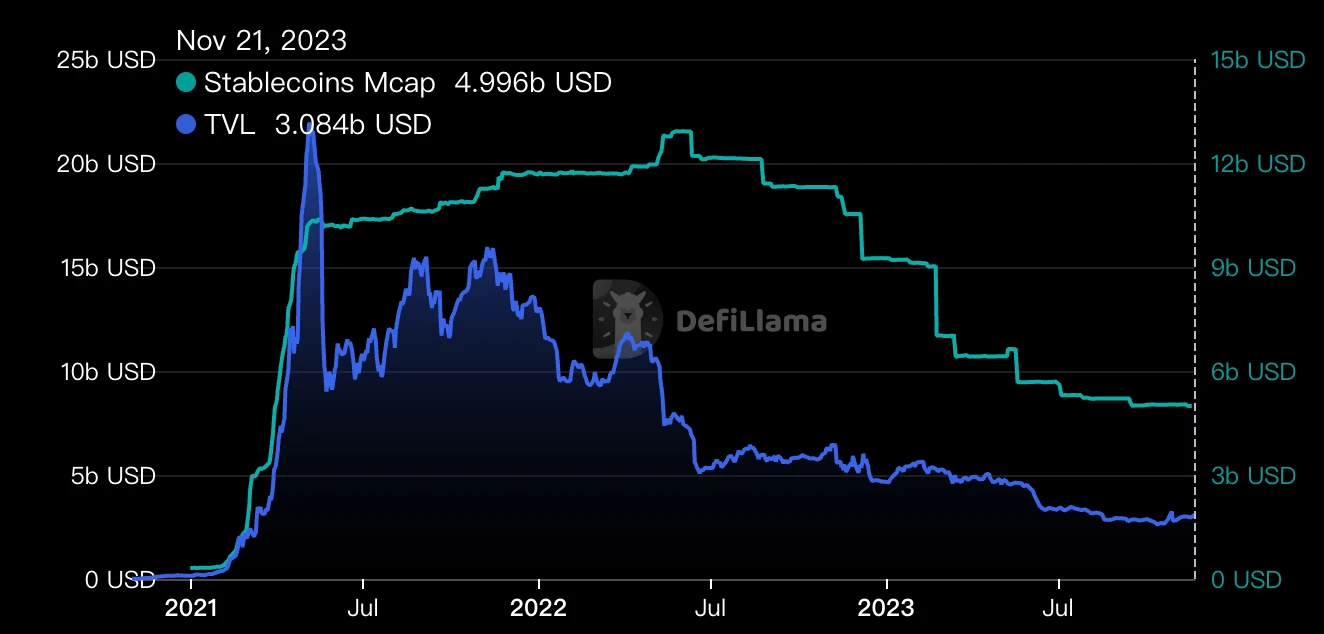
Source: DefiLlama, November 2023
B. The Impact of TUSD on the Tron Ecosystem
After a series of operations post-February 2023, TUSD's market capitalization rose from around $1 billion to $2-3 billion.
Table: A Series of Compliance Operations for TUSD
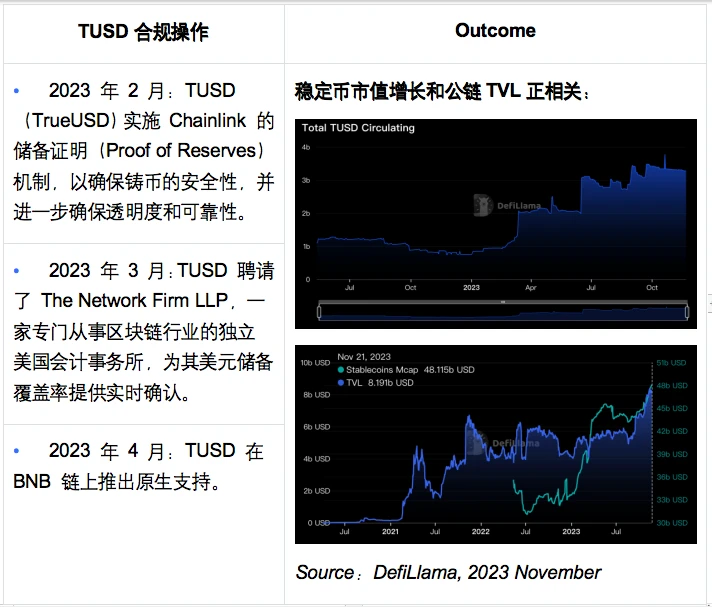
C. USDC and Public Chains
USDC has been issued on over 15 public chains, with the top three in TVL being ETH, Solana, and Polygon. USDC is seeking to expand its application scenarios, primarily in payments, especially in cross-border payments.
Table: USDC's TVL Distribution Across Different Public Chains
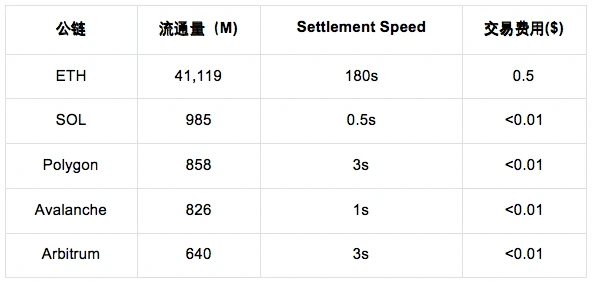
Source: State of the USDC Economy, Circle Annual Report, 2023
USDC <-> Solana: Recently, Visa announced a partnership with Circle to use Circle's USDC as an on-chain settlement tool on the Solana blockchain. This collaboration is an important step in merging traditional financial services with cryptocurrency technology, aiming to provide faster and cheaper cross-border payment solutions. The choice of the Solana blockchain is due to its high throughput and low transaction costs, making it suitable for handling large volumes of small payments. This innovative payment method is expected to have a significant impact on the global payment sector, especially in accelerating cross-border transaction processing.
USDC <-> Polygon: In October 2023, Circle announced support for the native issuance of USDC on the Polygon PoS mainnet; mainstream protocols in the Polygon ecosystem, such as AAVE, Compound, Curve, QuickSwap, and Uniswap, indicated they would invest in developer support for native USDC. Additionally, Circle expects to achieve integration of CCTP with the Polygon PoS Bridge by the end of 2023 to enable cross-chain interoperability.
USDC <-> Sei: In mid-November 2023, Circle strategically invested in Sei Network to support on-chain native USDC. The official announcement stated that Sei's performance is superior compared to Sui, Solana, and Aptos, with a TTF of 0.25.
D. DApps Issuing Stablecoins and Public Chains
The impact of stablecoins issued by leading DeFi protocols on public chains is a noteworthy area to observe. Taking Curve and AAVE as examples, their actions in the stablecoin space have significant implications for the entire cryptocurrency market and the application of blockchain technology.
Curve's crvUSD stablecoin, launched in May 2023, is a protocol that uses stablecoins as a medium for on-chain asset collateralized lending. The protocol supports users in using a range of crypto assets (such as ETH, WETH, wstETH, WBTC, etc.) as collateral to mint crvUSD. Particularly after June 2023, the support for WBTC as collateral significantly propelled the growth of crvUSD. As of November 2023, the scale of collateral exceeded $100 million.
In May 2023, most of Curve's collateral was FRAX's sfrxETH, but it subsequently supported Lido's wstETH and BitGo's WBTC, with these newly supported collaterals quickly capturing a significant market share. This indicates that Curve has substantial influence over which tokens are supported as collateral. This strategy not only expands Curve's influence in the DeFi space but may also have far-reaching effects on asset liquidity and the usage of stablecoins on public chains.
Such initiatives by leading DeFi protocols demonstrate the innovation and dynamism in the DeFi sector while highlighting the important role these protocols play in the cryptocurrency ecosystem. As more DeFi protocols engage in the issuance and management of stablecoins, we can expect new changes and challenges to arise regarding the use of public chains, the liquidity of cryptocurrencies, and the overall stability of the market.
crvUSD Collateral
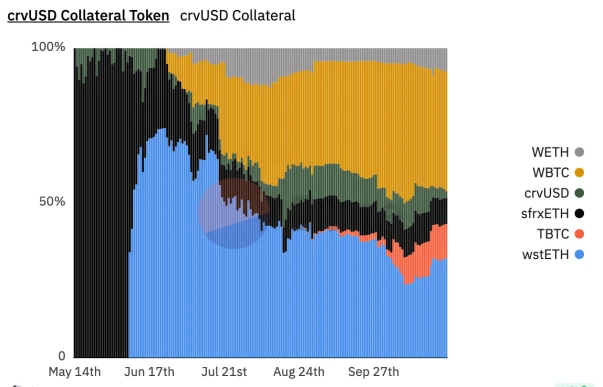
crvUSD TVL
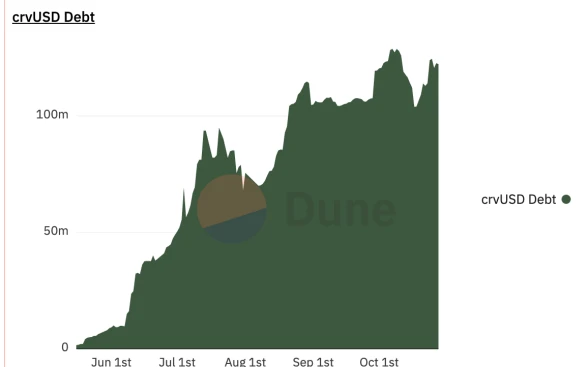
Source: https://dune.com/Marcov/crvusd, November 2023
Aave, as the largest lending protocol, has a TVL of $5.64 billion, and its launched GHO is an overcollateralized stablecoin, so all tokens supported by the Aave v3 protocol can be used as collateral. This collateral continues to generate revenue within the lending protocol. Since its launch in July, the cumulative TVL has exceeded $20 million.
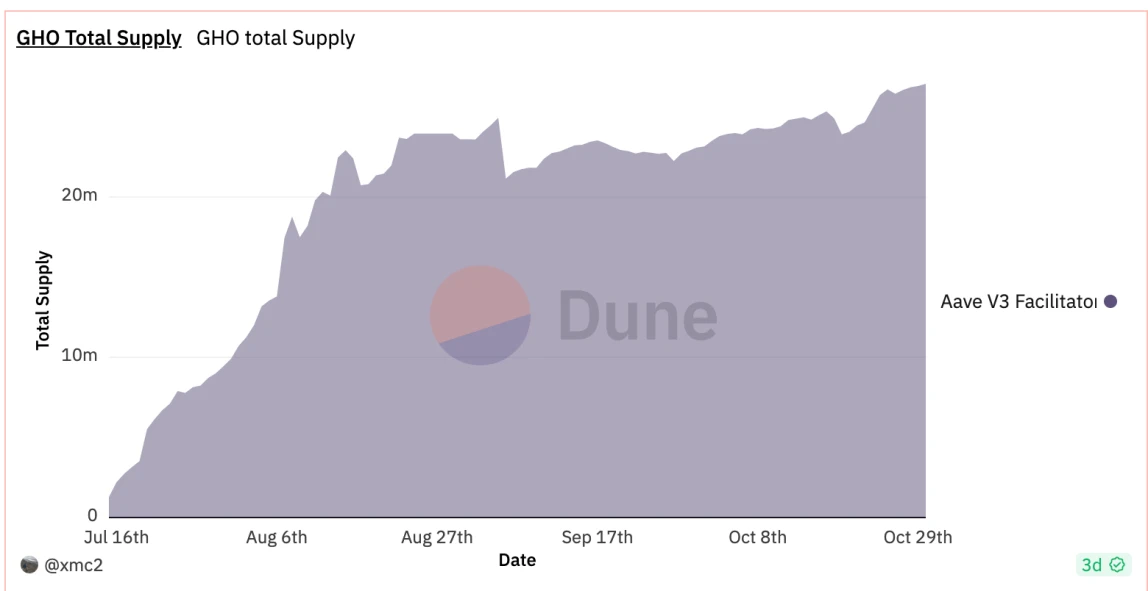
Source: Dune Analytics, November 2023
3. Stablecoin Issuers
Currently, most stablecoin projects have their underlying assets primarily in dollars and other highly liquid short-term assets, with the risk of default on the underlying assets being almost zero. Centralized institutions that issue stablecoins need to ensure smooth channels for users to buy and exit; the greatest risk lies in the issuer's failure to redeem during the exit process, which could lead to the collapse of the ecosystem.
Finding a trustworthy stablecoin issuer is an important topic for ecosystem participants. Analyzing the cryptocurrency ecosystem and traditional financial market systems, crypto-native custodians and traditional financial institutions such as banks and asset management platforms have absolute credibility, such as Fireblocks, Bitgo, and BNY Mellon, BlackRock, which are more suitable as stablecoin issuers.
Drawing from the management methods of ETF assets, multiple parties can use "monitoring sharing agreements" to ensure the transparency and openness of fund storage and liquidity extraction, which will also enhance credibility. Additionally, combining third-party on-chain audits and on-chain data tracking platforms like OKLink can jointly supervise fund security.
4. Regulatory Bodies:
The regulatory framework for cryptocurrencies in the U.S. has not yet been officially established. Until then, according to the U.S. Federal Securities Laws, if a digital asset qualifies as an "investment contract" under the four-part test established by the 1933 Securities Act and the 1934 Securities Exchange Act, it is considered a "security." The U.S. Securities and Exchange Commission (SEC) first applied the Howey Test (a legal test to determine whether a particular transaction qualifies as a security) to digital assets in 2017. Although the 2019 framework outlined many non-determinative factors that the SEC might consider in determining whether a digital asset is a security, SEC Chairman Gary Gensler stated in April 2022 that he believes nearly all digital assets are securities.
Some senators in the U.S. Congress are working to create a broad regulatory framework for digital assets and plan to grant most oversight responsibilities to the Commodity Futures Trading Commission (CFTC). In April 2023, the first regulatory bill regarding payment stablecoins was introduced, which was revised in July 2023. This indicates that there is currently no specific regulatory framework for stablecoins. However, stablecoin issuers must comply with existing regulatory and legal requirements, such as meeting anti-money laundering (AML) and Know Your Customer (KYC) requirements from the Financial Crimes Enforcement Network (FinCEN) and obtaining money transmission licenses from various states. However, the bill does not specify who the federal regulatory authority for payment stablecoins is.
The SEC's approach to regulating centralized stablecoin projects has sparked some discussions within the industry. The SEC's strategy of "regulating through enforcement" is seen by some insiders as questionable. For example, in June 2023, the SEC directed Paxos to suspend the issuance of BUSD and classified it as a security. In response to this approach, Circle defended the use of its stablecoin USDC, emphasizing that USDC is primarily used for payments rather than as an investment tool, and therefore should not fall under the SEC's regulatory purview. Additionally, in November 2023, PayPal's issued stablecoin PYUSD also attracted the SEC's attention. SEC Chairman Gary Gensler mentioned in an April 2023 interview with New York Magazine that most cryptocurrencies may be considered securities and thus subject to corresponding regulation. The regulatory outlook for the U.S. stablecoin market remains unclear, and the industry continues to monitor it closely.
In the current regulatory environment, stablecoin issuers indeed face a series of challenges and opportunities. Following best practices, including efforts to obtain cryptocurrency licenses issued by state governments, especially the "Money Transmitter License" and New York's "BitLicense," is crucial for stablecoin issuers.
Paxos has obtained a BitLicense from New York and Money Transmitter Licenses from other states, providing a foundation for compliant operations. These licenses not only ensure that the company operates within a strict legal framework but also enhance customer trust in its business. For the future development of stablecoins, if the focus is on interoperability with traditional financial systems, support for real-world assets (RWA), and long-term sustainability, companies that can quickly obtain these licenses and regulatory approvals will have a competitive advantage. This strategy may provide emerging companies with the opportunity to challenge market-dominating companies like Circle.
Additionally, the U.S. Internal Revenue Service (IRS) defines digital assets as property and includes them in the tax system, which is an important consideration for stablecoin issuers and the entire cryptocurrency industry. Tax compliance for cryptocurrency transactions is a key area, and as the market evolves and regulation strengthens, this area may continue to change and develop.
Therefore, stablecoin issuers need to not only pay attention to existing regulatory requirements but also closely monitor potential new regulations and changes in the future to ensure their business can adapt to market and regulatory shifts.
Outside the U.S., the Mica (Markets in Crypto-Assets) Act, particularly targeting EU member states, proposes a series of clear regulations regarding stablecoins and related crypto assets, significantly impacting the cryptocurrency industry. The act does not support algorithmic stablecoins and prohibits stablecoins from generating yields, classifying yield-generating tokens as securities. This poses challenges for the regulation of centralized stablecoins, as the underlying assets of such stablecoins may generate yields. If the yields belong to users, stablecoins are more likely to be viewed similarly to money market funds and thus classified as securities. Therefore, newly issued tokenized projects are often regarded as securities-type assets. To comply with these regulations, the industry typically collaborates with exchanges, payment service providers, wallets, and various DeFi protocols to provide incentive schemes for users through indirect means. Meanwhile, other regions such as Singapore and Hong Kong are also formulating their own stablecoin regulatory frameworks, with the Hong Kong Monetary Authority expected to introduce a stablecoin regulatory framework in the first quarter of 2024. These regulatory measures aim to provide more transparency and security in the crypto asset market while posing new challenges to the definition and operation of stablecoins. As the regulatory frameworks of different countries and regions gradually clarify, stablecoin issuers and users need to closely monitor these changes to ensure compliance.
5. Custodial Service Providers:
The brief decoupling event of USDC due to the bankruptcy of SVB in 2023 highlights the importance of secure management of underlying assets.
Some stablecoin projects, such as PYUSD, mitigate certain risks by entrusting the management of underlying assets to Paxos, a compliant and licensed custodian service provider. Paxos holds a cryptocurrency operating license under New York's BitLicense and is regulated by the New York State Department of Financial Services (NYDFS), isolating certain risks by entrusting assets to a third-party compliant custodial service provider.
Additionally, Circle has established a partnership with BlackRock, the world's largest asset management company, to create the Circle Reserve Fund, which is registered with the SEC and regulated by it, primarily to manage USDC reserves, with approximately 94% of reserves held in this institution.
6. Traditional Trust Companies:
Based on the author's research on multiple stablecoin issuers, most stablecoin issuers store their underlying assets in trust-type companies and often use SPV structures in their company designs to legally protect and isolate users' underlying assets. Establishing Special Purpose Vehicles (SPVs) to achieve complete isolation of users' underlying assets from company assets is an effective risk management strategy. This arrangement ensures that, legally, the ownership of users' underlying assets belongs to the SPV, so in the event of group bankruptcy, even if the SPV is a subsidiary, it will not be affected, achieving bankruptcy remoteness.
Delaware is favored as the location for establishing corporate entities due to its bankruptcy court's extensive experience in handling corporate law cases. Delaware courts provide rich guidance on such cases, helping to ensure legal safeguards.
For centralized stablecoins, since their anchored underlying assets are typically off-chain assets, human involvement during operations should be minimized and automated. This approach can reduce losses caused by human error and increase system transparency and efficiency. Automated processes not only enhance operational consistency and reliability but also help reduce the potential for manipulation and fraud, providing a higher level of protection for users and investors. In summary, by establishing SPVs in Delaware, achieving asset isolation, and automating operational processes, the security and stability of centralized stablecoins can be significantly enhanced, which is crucial for the healthy development of the cryptocurrency industry.
7. On-chain Infrastructure:
M^ZERO Labs provides an outstanding example of on-chain infrastructure, focusing on building decentralized infrastructure that allows institutional participants to allocate and manage assets on-chain. The platform operates in a fully transparent, open-source, and composable manner, connecting certified financial institutions that comply with local regulations and other decentralized applications to facilitate on-chain value transfer and collaboration among participants.
V. Conclusion
As the cryptocurrency market transitions from the peak of 2021 to the bear market of 2023, stablecoins, as a unique and important category, have not only demonstrated significant resilience amid market turmoil but also highlighted their core role in the entire crypto ecosystem. The market has shrunk from $3 trillion at its peak to $1 trillion, but the relative stability of stablecoin market capitalization during this process reveals its potential as a "safe haven" within the cryptocurrency ecosystem. Dominant stablecoins like USDT and USDC, with their stability and high liquidity in the market, have become indispensable parts of the crypto market.
At the same time, the rapid development and diversification of the stablecoin market reflect ongoing innovation in the cryptocurrency space. From overcollateralized to algorithmic stablecoins, the market's diversity shows its adaptability and responsiveness to various financial needs. The innovations of these emerging stablecoins, such as diversified collateral, liquidation mechanisms, and profit-sharing strategies, not only enhance the robustness of the DeFi ecosystem but also provide experiments for potential market transformations in the future.
The rapidly changing regulatory environment is also a key factor influencing the future of stablecoins. As governments and regulatory bodies gradually intervene and formulate policies and regulations regarding cryptocurrencies and stablecoins, the development of stablecoins will inevitably be affected by these external factors. Strengthened regulation may lead the market towards a more centralized direction, but it also brings new collaboration opportunities for stablecoins, particularly with traditional financial institutions and regulatory bodies.
Looking ahead, the role of stablecoins in the cryptocurrency ecosystem is expected to continue to expand. With technological advancements and the maturation of the regulatory environment, we may witness broader applications of stablecoins in financial services, especially in cross-border payments and settlements. However, achieving this requires the industry to make further efforts in transparency, security, and compatibility with existing financial systems.
In summary, stablecoins are not merely a branch of the crypto market; they play a crucial bridging role in connecting the traditional financial and digital currency worlds. Their development will be an ongoing process that requires continuous innovation, adaptation, and collaboration to find their place in a dynamic market and regulatory environment. In this process, understanding and adapting to these changes will be key to achieving long-term success for market participants. (The content described in this article is solely for industry ecological research, and all commercial and policy information is publicly available; the article does not endorse or guide any project.)
Appendix: Total Overview of Stablecoins
Source: https://messari.io/assets/stablecoins, November 2023
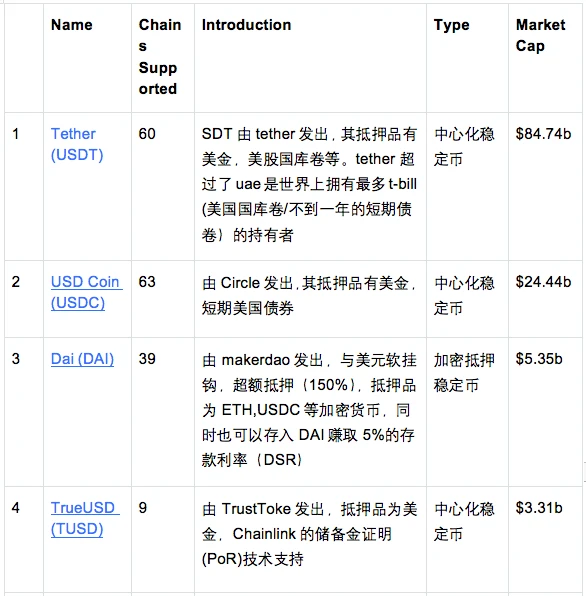
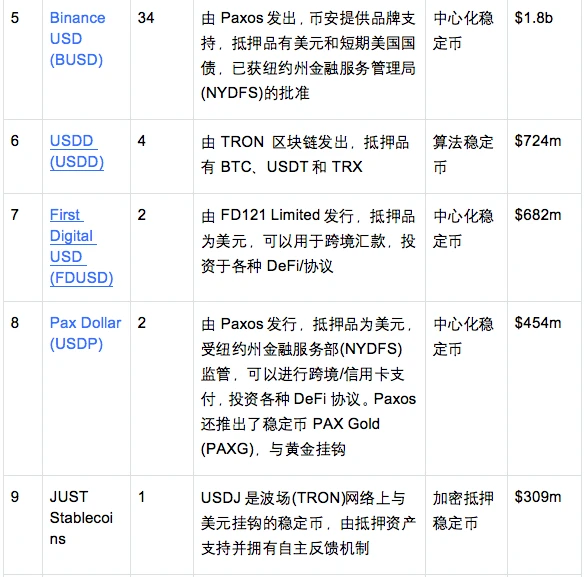
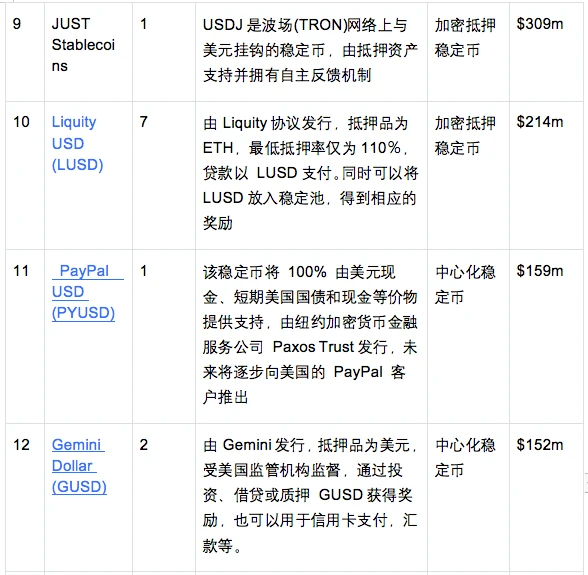
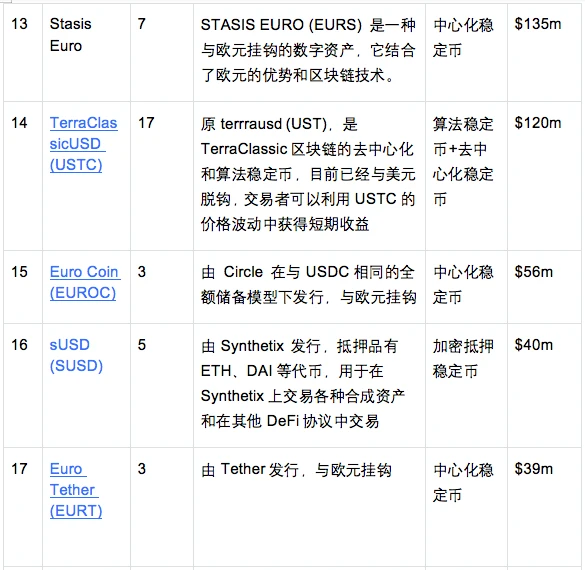
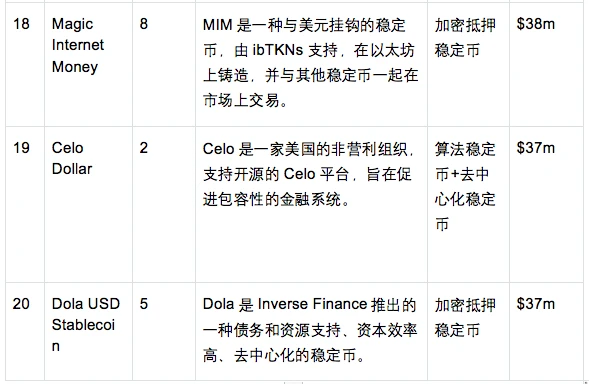
Disclaimer: The content described in this article is solely for industry ecological research, and all commercial and policy information is publicly available; the article does not endorse or guide any project.










